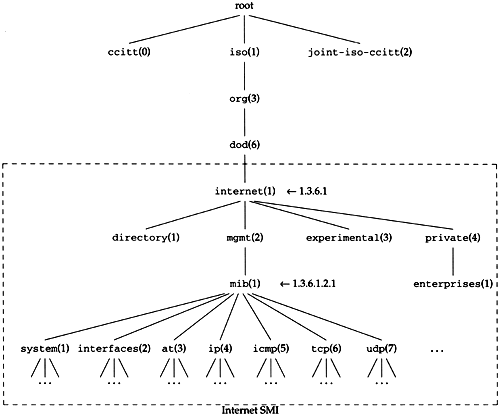25.4 Object Identifiers
25.4 Object Identifiers
An object identifier is a data type specifying an authoritatively named object. By " authoritative " we mean that these identifiers are not assigned randomly , but are allocated by some organization that has responsibility for a group of identifiers.
An object identifier is a sequence of integers separated by decimal points. These integers traverse a tree structure, similar to the DNS (Figure 14.1) or a Unix filesystem. There is an unnamed root at the top of the tree where the object identifiers start. (This is the same direction of tree traversal that's used with a Unix filesystem.)
Figure 25.6 shows the structure of this tree when used with SNMP. All variables in the MIB start with the object identifier 1.3.6.1.2.1.
Figure 25.6. Object identifiers in the Management Information Base.

Each node in the tree is also given a textual name. The name corresponding to the object identifier 1.3.6.1.2.1 is iso.org.dod.internet.mgmt.mib. These names are for human readability. The names of the MIB variables that are in the packets exchanged between the manager and agent (Figure 25.2) are the numeric object identifiers, all of which begin with 1.3.6.1.2.1.
Besides the mib object identifiers in Figure 25.6 we also show one named iso.org.dod.internet.private. enterprises (1.3.6.1.4.1). This is where vendor-specific MIBs are located. The Assigned Numbers RFC lists around 400 identifiers registered below this node.
EAN: 2147483647
Pages: 378